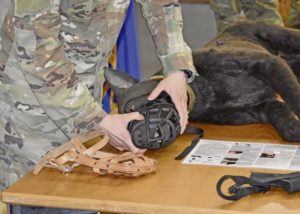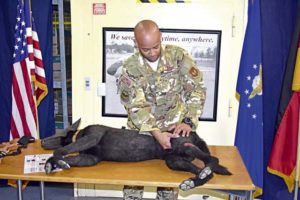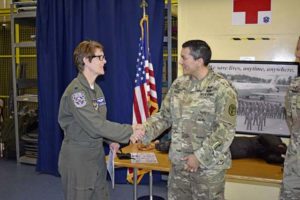Story and photos by Michelle Thum
Regional Health Command Europe
Veterinary Medical Center Europe veterinarians trained flight nurses and technicians of the 86th Aeromedical Evacuation Squadron on treatment and management of military working dogs last week at Ramstein Air Base.
Military working dog training is a new item on the contingency medical readiness program, a yearly review of a flight nurse and technician’s skills, to assure they are up-to-date with their trainings.

“In today’s world, military working dogs are essential to carry out the broad majority of our missions,” said Maj. Renee Krebs, a surgeon at Veterinary Medical Center Europe. “We rely heavily on our MWDs for target odor detection, such as explosives and drugs, in combat operations abroad and installation security at home. We need to ensure that flight nurses and technicians know how to properly evacuate them from combat zones and care for them during the flight.”
The 86th AES provides airlift support and aeromedical evacuation to the European and African areas of responsibility.
This was the first time the 86th AES received the training, which helped flight medics and nurses become more familiar with handling and management, evaluation and treatment, and understanding the vital signs of military working dogs.
“We see a move from a clinical to a more battlefield-focused mindset,” said Capt. David O’Brien, flight nurse with the 86th AES. “This also includes MWDs, since we utilize them during our missions. We routinely pick up [human] patients and care for them during the flight to maintain stability of the patient as we evacuate them to immediate medical care, but military working dogs are less common.” In missions to the Middle East, one to two dogs will be evacuated in a four-month period.
“Evacuating an MWD is a low-volume, high-risk procedure.” said O’Brien.
Injured MWDs are typically accompanied by a handler. The training helped the flight care team to gain familiarity with procedures, and to help and assist, rather than hinder, a handler during a flight.
The training highlighted the difference between medical care and veterinary care.
“Approaching a dog is much different than approaching a human. Learning how to pick up on body language and nonverbal hints helped a lot,” explained O’Brien. “During flights we check the vital signs of our patients and with the help of hero dog, a dog-like mannequin, we were taught how to do that on dogs.”
The veterinarians and the 86th AES are looking forward to working together in the future.
“Our goal is to draft real-life cases, medical scenarios, in which we show how we operate and have the flight nurses assist us,” Krebs said.









